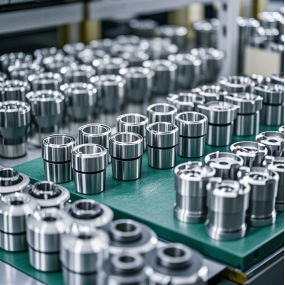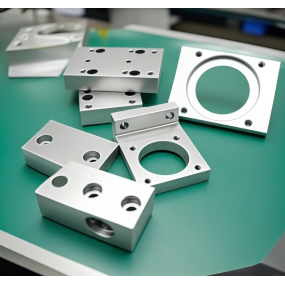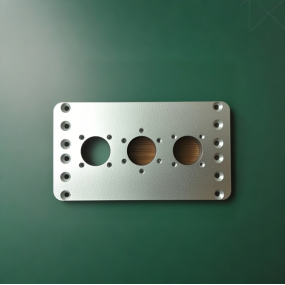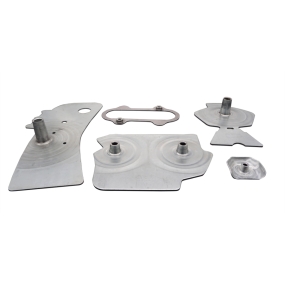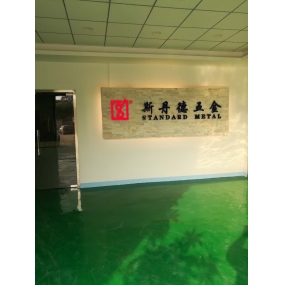In precision Sheet Metal Processing, in order to avoid corrosion during operation, measures can be taken from the aspects of material selection, processing process control, surface treatment, environmental control, etc., as follows:  material selection Corrosion-resistant materials: According to the use environment and performance requirements of sheet metal parts, choose the appropriate corrosion-resistant materials. For example, in the environment of wet or corrosive media such as acid and alkali, stainless steel can be selected. Among them, 304 stainless steel has good corrosion resistance and versatility. 316 stainless steel has better performance in pitting corrosion resistance and chloride ion corrosion resistance due to the addition of molybdenum. For some occasions where weight is required and certain corrosion resistance is required, aluminum alloy, such as 5052 aluminum alloy, can be selected, which has better corrosion resistance. Check the quality of materials: Make sure that the quality of the sheet metal materials purchased is qualified, and there are no surface defects, impurities and other factors that may cause corrosion. Before the materials are put into storage, strict inspections should be carried out, including appearance inspection, chemical composition analysis, physical property testing, etc., to prevent unqualified materials from entering the processing link. Processing process control Optimize the cutting process: During the cutting process, appropriate cutting methods and parameters should be selected to reduce the thermal impact of cutting and surface roughness. For example, laser cutting has the advantages of high cutting accuracy and small heat-affected zone, which can effectively reduce the surface oxidation and microscopic defects caused by cutting and reduce the risk of corrosion. At the same time, control the cutting speed and power to avoid problems such as overheating and slag adhesion on the cutting surface, and prevent these parts from becoming a source of corrosion. Reduce processing stress: In the forming process of sheet metal bending, stamping, etc., it is necessary to reasonably control the processing parameters to avoid excessive stress. Because the stress concentration parts are prone to corrosion cracking in subsequent use. For example, by optimizing the mold design, adjusting the stamping speed and pressure, etc., the sheet metal parts are evenly stressed during the forming process and the stress concentration is reduced. Keep the processing environment clean: The processing workshop should be kept clean to avoid dust, oil, acid and alkali and other corrosive substances from contacting the sheet metal parts. Regularly clean the processing equipment and working area to prevent debris and corrosive media from adhering to the sheet metal surface during processing and causing corrosion. Surface treatment Passivation treatment: For sheet metal parts made of stainless steel and other materials, passivation treatment is a commonly used anti-corrosion method. By soaking sheet metal parts in a passivation solution, a dense passivation film is formed on their surface to improve corrosion resistance. For example, passivation treatment with a mixed solution of nitric acid and hydrofluoric acid can effectively remove impurities such as iron ions on the surface of stainless steel and form a stable passivation film. Electroplating treatment: Electroplating is the plating of a layer of metal or alloy on the surface of sheet metal parts, such as nickel plating, chrome plating, galvanizing, etc., to isolate the contact between the external corrosive medium and the sheet metal substrate. For example, the galvanized layer has good corrosion resistance and cost-effectiveness, and is widely used in the protection of various sheet metal parts. In the electroplating process, it is necessary to strictly control the electroplating process parameters, such as bath composition, temperature, current density, etc., to ensure that the coating is uniform, dense and void-free. Painting treatment: Painting is a simple and effective anti-corrosion method. Applying a layer of corrosion-resistant paint or coatings on the surface of sheet metal parts, such as epoxy paint, polyurethane paint, etc., can form a physical barrier to prevent oxygen, moisture and other corrosive media from contacting the sheet metal surface. Before painting, the sheet metal surface needs to be pretreated with degreasing, rust removal, etc., to improve the adhesion and protective properties of the paint layer.
material selection Corrosion-resistant materials: According to the use environment and performance requirements of sheet metal parts, choose the appropriate corrosion-resistant materials. For example, in the environment of wet or corrosive media such as acid and alkali, stainless steel can be selected. Among them, 304 stainless steel has good corrosion resistance and versatility. 316 stainless steel has better performance in pitting corrosion resistance and chloride ion corrosion resistance due to the addition of molybdenum. For some occasions where weight is required and certain corrosion resistance is required, aluminum alloy, such as 5052 aluminum alloy, can be selected, which has better corrosion resistance. Check the quality of materials: Make sure that the quality of the sheet metal materials purchased is qualified, and there are no surface defects, impurities and other factors that may cause corrosion. Before the materials are put into storage, strict inspections should be carried out, including appearance inspection, chemical composition analysis, physical property testing, etc., to prevent unqualified materials from entering the processing link. Processing process control Optimize the cutting process: During the cutting process, appropriate cutting methods and parameters should be selected to reduce the thermal impact of cutting and surface roughness. For example, laser cutting has the advantages of high cutting accuracy and small heat-affected zone, which can effectively reduce the surface oxidation and microscopic defects caused by cutting and reduce the risk of corrosion. At the same time, control the cutting speed and power to avoid problems such as overheating and slag adhesion on the cutting surface, and prevent these parts from becoming a source of corrosion. Reduce processing stress: In the forming process of sheet metal bending, stamping, etc., it is necessary to reasonably control the processing parameters to avoid excessive stress. Because the stress concentration parts are prone to corrosion cracking in subsequent use. For example, by optimizing the mold design, adjusting the stamping speed and pressure, etc., the sheet metal parts are evenly stressed during the forming process and the stress concentration is reduced. Keep the processing environment clean: The processing workshop should be kept clean to avoid dust, oil, acid and alkali and other corrosive substances from contacting the sheet metal parts. Regularly clean the processing equipment and working area to prevent debris and corrosive media from adhering to the sheet metal surface during processing and causing corrosion. Surface treatment Passivation treatment: For sheet metal parts made of stainless steel and other materials, passivation treatment is a commonly used anti-corrosion method. By soaking sheet metal parts in a passivation solution, a dense passivation film is formed on their surface to improve corrosion resistance. For example, passivation treatment with a mixed solution of nitric acid and hydrofluoric acid can effectively remove impurities such as iron ions on the surface of stainless steel and form a stable passivation film. Electroplating treatment: Electroplating is the plating of a layer of metal or alloy on the surface of sheet metal parts, such as nickel plating, chrome plating, galvanizing, etc., to isolate the contact between the external corrosive medium and the sheet metal substrate. For example, the galvanized layer has good corrosion resistance and cost-effectiveness, and is widely used in the protection of various sheet metal parts. In the electroplating process, it is necessary to strictly control the electroplating process parameters, such as bath composition, temperature, current density, etc., to ensure that the coating is uniform, dense and void-free. Painting treatment: Painting is a simple and effective anti-corrosion method. Applying a layer of corrosion-resistant paint or coatings on the surface of sheet metal parts, such as epoxy paint, polyurethane paint, etc., can form a physical barrier to prevent oxygen, moisture and other corrosive media from contacting the sheet metal surface. Before painting, the sheet metal surface needs to be pretreated with degreasing, rust removal, etc., to improve the adhesion and protective properties of the paint layer.
Hello! Welcome to EMAR's website!
 English
English » »
» »
 Spanish
Spanish Arabic
Arabic French
French Portuguese
Portuguese Belarusian
Belarusian Japanese
Japanese Russian
Russian Malay
Malay Icelandic
Icelandic Bulgarian
Bulgarian Azerbaijani
Azerbaijani Estonian
Estonian Irish
Irish Polish
Polish Persian
Persian Boolean
Boolean Danish
Danish German
German Filipino
Filipino Finnish
Finnish Korean
Korean Dutch
Dutch Galician
Galician Catalan
Catalan Czech
Czech Croatian
Croatian Latin
Latin Latvian
Latvian Romanian
Romanian Maltese
Maltese Macedonian
Macedonian Norwegian
Norwegian Swedish
Swedish Serbian
Serbian Slovak
Slovak Slovenian
Slovenian Swahili
Swahili Thai
Thai Turkish
Turkish Welsh
Welsh Urdu
Urdu Ukrainian
Ukrainian Greek
Greek Hungarian
Hungarian Italian
Italian Yiddish
Yiddish Indonesian
Indonesian Vietnamese
Vietnamese Haitian Creole
Haitian Creole Spanish Basque
Spanish Basque


